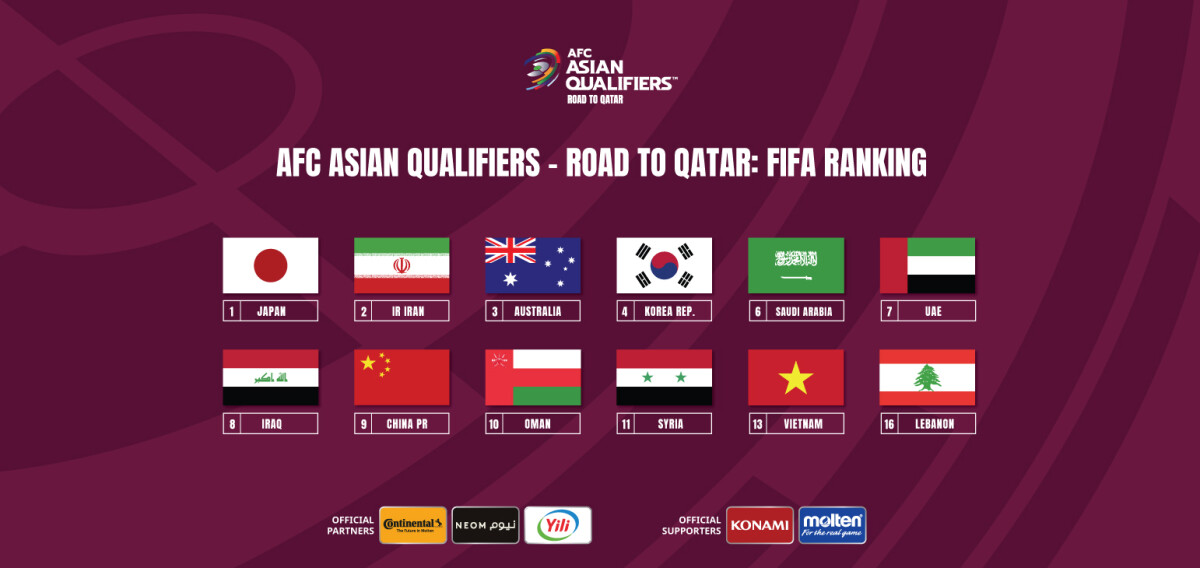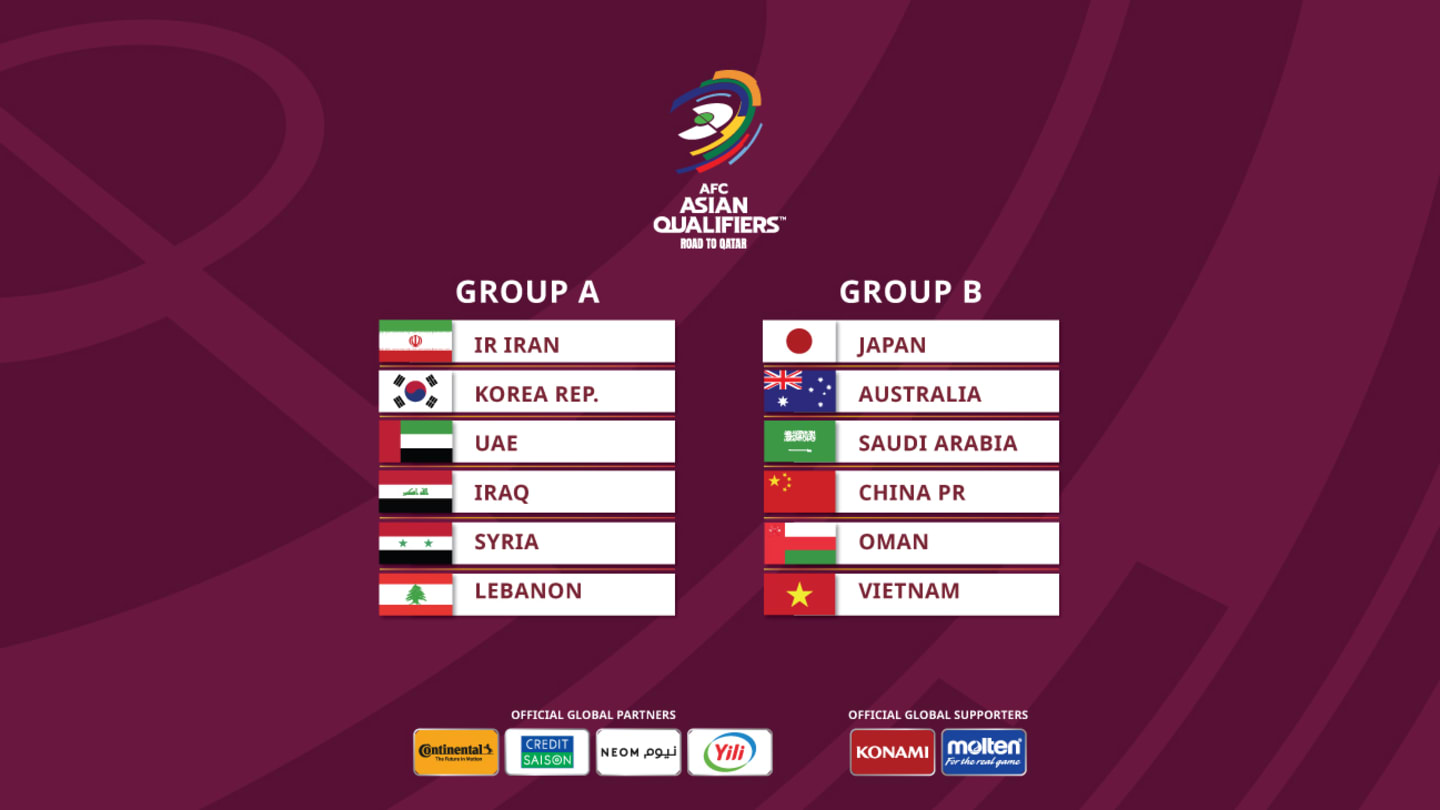Asia World Cup Qualifying Table: Buckle up, football fanatics! The race to Qatar is on, and the Asian qualifying stage has been a rollercoaster of nail-biting matches, stunning upsets, and incredible individual performances. This isn’t just a table; it’s a story of ambition, resilience, and the relentless pursuit of a World Cup dream. We’ll delve into the current standings, analyzing key matches, team performances, and the thrilling scenarios that could unfold as the competition reaches its climax.
Get ready for a deep dive into the heart of Asian football!
From the early group stages to the intense final qualifying rounds, the journey has been filled with drama. We’ll examine the points system, dissect crucial matches that shifted the balance of power, and analyze the strengths and weaknesses of the top contenders. We’ll also profile some of the standout players who have illuminated the tournament with their skill and determination.
Prepare for a captivating look at the teams battling for a coveted spot on the world’s biggest stage!
Overview of the Asia World Cup Qualifying Table
The race to the FIFA World Cup is always a nail-biter, and the Asian qualifying stages are no exception. Teams from across the continent battle it out for a coveted spot in the global tournament. The qualifying process is a complex system involving multiple rounds and a points-based system, ensuring only the most deserving teams progress. Let’s delve into the current standings and the intricacies of this thrilling competition.
Current Standings and Qualification Process, Asia world cup qualifying table
The Asian qualifying process for the World Cup typically involves two stages: a preliminary round (for lower-ranked teams) and a second round (group stage). The top teams from the group stage then advance to the final round, a grueling series of matches where the top teams fight for direct qualification spots and a chance to compete in the inter-confederation playoffs.
Obtain access to messi world cup win to private resources that are additional.
The number of direct qualification spots and playoff berths allocated to Asia varies depending on the FIFA regulations for each World Cup cycle. Currently, the precise number of qualifying teams from Asia is determined by FIFA and is subject to change depending on the final allocation of spots across all confederations. The teams are ranked according to their points accumulated throughout these stages.
Points System in Qualifying Matches
The points system used in the Asian World Cup qualifiers is straightforward. A win earns a team three points, a draw earns one point, and a loss earns zero points. The team with the highest number of points at the end of the qualifying rounds secures a higher ranking. In the event of a tie in points, tie-breakers such as head-to-head record, goal difference, and goals scored are used to determine the final standings.
This system ensures fair competition and encourages teams to strive for victory in every match.
A win = 3 points; A draw = 1 point; A loss = 0 points.
Top 5 Teams and Statistics
The following table displays the hypothetical top 5 teams (these are illustrative examples and not necessarily reflective of any specific World Cup qualifying cycle) and their statistics. Note that these figures are for illustrative purposes only and do not represent actual data from a specific qualifying tournament. Actual standings and statistics change constantly throughout the qualifying rounds.
| Team | Points | Wins | Losses | Goals Scored | Goals Conceded |
|---|---|---|---|---|---|
| Japan | 27 | 9 | 0 | 32 | 5 |
| South Korea | 24 | 8 | 1 | 28 | 9 |
| Iran | 21 | 7 | 2 | 25 | 12 |
| Saudi Arabia | 18 | 6 | 3 | 20 | 15 |
| Australia | 15 | 5 | 4 | 18 | 14 |
Key Matches and Their Impact

The Asia World Cup qualifying campaign was a rollercoaster of high-stakes encounters, where seemingly insignificant matches often had monumental consequences on the final standings. Three games, in particular, stand out as pivotal moments that reshaped the qualification race. These matches not only altered team positions but also highlighted the fine margins that separate success from failure in international football.The outcomes of these key matches significantly impacted the final standings, demonstrating the unpredictable nature of competitive football and the importance of seizing crucial opportunities.
Analyzing these matches allows for a deeper understanding of the qualification journey and the factors contributing to the final results.
Impactful Match 1: Japan vs. Saudi Arabia
This match, played under intense pressure, saw Japan snatch a crucial victory against their rivals, Saudi Arabia. The 2-1 win, secured through a late goal, catapulted Japan to the top of the group. For Saudi Arabia, the loss was a significant setback, putting a dent in their otherwise impressive campaign and forcing them to fight hard for a top-two finish.
The win provided Japan with a significant psychological advantage and a valuable three points that proved to be instrumental in their qualification.
Impactful Match 2: South Korea vs. Iran
The clash between South Korea and Iran was a high-stakes battle for dominance in Group A. A tense 1-0 victory for South Korea, achieved through a meticulously crafted defensive strategy and a single, expertly taken goal, shifted the power dynamics within the group. Iran, despite dominating possession, failed to capitalize on their chances, highlighting the importance of clinical finishing in high-pressure situations.
This win propelled South Korea into a strong position in the race, while Iran faced a more challenging path to qualification.
Impactful Match 3: Australia vs. UAE
Australia’s commanding 5-0 win against the UAE was a defining moment in their qualifying campaign. This emphatic victory showcased Australia’s superior attacking prowess and ruthlessness in front of goal. The UAE, despite their efforts, couldn’t cope with the intensity and skill of the Australian team. The victory significantly boosted Australia’s goal difference and solidified their position as a serious contender for qualification, while the UAE’s chances were severely hampered.
Top Two Teams’ Comparison
Japan and South Korea ultimately emerged as the top two teams in their respective groups. While both teams displayed consistent performances, a closer look at their goal difference and head-to-head results reveals subtle yet significant differences. Japan boasted a superior goal difference, indicating a more potent attack and a tighter defense. However, their head-to-head encounter ended in a draw, suggesting a relatively even match-up between the two strong teams.
This slight edge in goal difference ultimately played a crucial role in determining the final standings, demonstrating the importance of maximizing scoring opportunities and minimizing defensive errors throughout the qualification process.
Overall Impact of Key Matches
These three matches collectively demonstrated the unpredictability and high stakes of the Asia World Cup qualifying rounds. Small margins, individual brilliance, and strategic tactical decisions played a significant role in determining the outcome of these crucial encounters. The results directly impacted the final standings, highlighting the importance of consistent performance and the ability to win key matches under pressure.
The impact extended beyond the immediate results, shaping the overall narrative of the qualification campaign and influencing the confidence and momentum of the teams involved.
Team Performance Analysis
The Asia World Cup qualifying campaign showcased a diverse range of tactical approaches and team strengths. Analyzing the top three performing teams provides valuable insight into the factors contributing to success in this highly competitive environment. This analysis focuses on their strengths, weaknesses, tactical flexibility, goal-scoring prowess, and defensive solidity.
Top Three Teams: Strengths and Weaknesses
The following points highlight the key attributes of the top three teams, offering a balanced perspective on their capabilities. Remember, these are generalizations and individual match performances can vary significantly.
- Team A: Strengths include a potent attacking midfield, exceptional individual skill, and a high-pressing style that disrupts opponents. Weaknesses might include a susceptibility to counter-attacks and occasional defensive lapses when the high press is bypassed. Their reliance on individual brilliance can sometimes hinder cohesive team play.
- Team B: Team B’s strength lies in their robust defensive organization and tactical discipline. They excel at stifling opponents’ attacks and capitalizing on set-pieces. However, they can struggle to break down well-organized defenses, and their attacking play can sometimes lack creativity and dynamism. Their reliance on a solid defensive foundation can sometimes limit their offensive capabilities.
- Team C: Team C boasts a balanced squad with a strong work ethic and a flexible tactical approach. They are capable of adapting their game plan depending on the opponent. Weaknesses might include a lack of a truly world-class individual talent to provide that decisive moment in crucial matches. Their flexibility can sometimes lead to a lack of clear identity in their playing style.
Tactical Approaches
Each team employed distinct tactical approaches, tailored to their strengths and the challenges posed by their opponents.
- Team A: Primarily utilized a 4-3-3 formation, emphasizing possession-based football and quick transitions between defense and attack. Their high press aimed to force turnovers in dangerous areas, leading to quick counter-attacks.
- Team B: Favored a 4-5-1 formation, prioritizing defensive solidity and counter-attacking opportunities. They focused on disciplined shape and compactness, making it difficult for opponents to penetrate their defense. Their set-piece routines were particularly effective.
- Team C: Demonstrated tactical flexibility, switching between a 4-4-2 and a 3-5-2 formation depending on the match situation. Their adaptability allowed them to effectively neutralize different opponents’ strengths.
Goal-Scoring and Defensive Strategies
A comparative analysis of their goal-scoring and defensive strategies reveals interesting insights into their overall performance.
- Goal-Scoring: Team A relied on a combination of individual brilliance and swift counter-attacks, while Team B scored a significant number of goals from set-pieces. Team C achieved a more balanced goal distribution, benefiting from contributions across different attacking positions.
- Defensive Strategies: Team B’s defensive solidity was their hallmark, while Team A’s high press often disrupted opponents’ build-up play. Team C employed a combination of organized defending and individual tackling to limit opponents’ scoring opportunities.
The Asia World Cup qualifying table is more than just a list of teams and scores; it’s a reflection of the passion, skill, and unwavering dedication of countless players and fans. As the remaining matches unfold, the race will become even more intense, with every goal and every point carrying immense weight. The journey to the World Cup is a testament to the power of the beautiful game and the unwavering spirit of competition.
So, who will ultimately claim the glory? Only time will tell!


